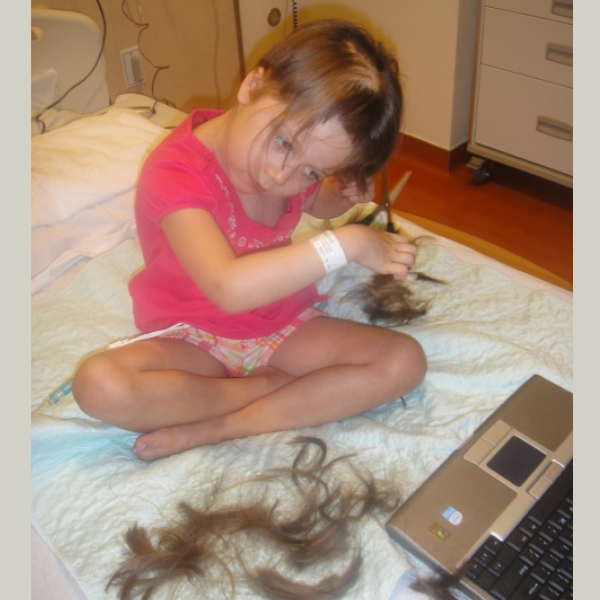
“You will need to pack your bags and head to Children’s Hospital, we think it’s leukemia.”
Only a few days after a Complete Blood Count, Christy, Hailey's mom, heard these words from Hailey’s doctor. Hailey had just started kindergarten.
At summer dance camp, Hailey won the award for “Most Tired.” That puzzled her mom. As kindergarten progressed, Christy noticed the fatigue. She assumed that kindergarten must be exhausting for children. Christmas was approaching when she noticed Hailey’s bruises, in odd places on her body.
Then, in the middle of the night, Hailey started screaming. The nosebleed had covered everything in her bed! They had an appointment scheduled with the allergist, so Christy asked about these unusual symptoms. The allergist ordered a CBC, or Complete Blood Count. She called that evening to say, “It’s not emergent, but urgent for you to meet with your pediatrician." Two days later, the call came in to pack their bags and go to Denver Children’s Hospital. It was December 23rd.
Hailey’s younger sister went to stay with Grandma in Denver. They explained to Hailey that the trip to the hospital would help solve the puzzle of her bad nosebleed and tiredness. She had a bone marrow biopsy and then her first transfusion on December 24th. Because it was Christmas, the attending physicians permitted Hailey to leave for two days to Grandma’s house in Denver.
After she returned to the hospital, they learned she would need a second bone marrow biopsy as the first showed a chromosomal abnormality. Nothing abnormal appeared in the second, so they ordered a third bone marrow aspirate. The results suggested that Hailey did not have Leukemia, but severe aplastic anemia instead.
Their normal life stopped as they began quarantining inside their house. Although friends wanted to help, the family didn’t know what they needed. They had to find the strength to deal with all they were facing. Their community rallied around the family, giving of themselves as well as unexpected, but appreciated gifts. These gestures of support helped Christy and the whole family cope with the heartbreak of this crisis.
Because the family was tested as potential matches for a bone marrow transplant upon Hailey’s admission, they knew that her younger sister was a good match. Yet her parents were reluctant. A nurse described how difficult the transplant process could be, so they opted to try ATG treatments first.
Fortunately, the hematologist had prepared the family for the ATG process. During the three months they waited to see if the treatment was successful, Hailey’s parents began considering transplantation. Christy says of this time, that she knew “in her heart-of- hearts” that the ATG would not be the cure they wanted. Finally, they had to deal with the fact that treatment, hospital time, and challenges for Hailey were not over. The doctor told them it was “Time to decide if your glass is half-full or half-empty.” Hailey’s condition had progressed to Very Severe Aplastic Anemia. The treatment options were repeating ATG or having a bone marrow transplant.
At this point, Hailey’s parents made a conscious decision. They decided to be transparent with Hailey, their inquisitive and intelligent little girl. They knew they had a child who thrived on asking “Why?” Advocating for Hailey, they brought in the Child Life Specialist to help explain why she needed the transplant. Christy knew this strategy worked well when Hailey announced, “I’m stronger than I tink I am!”
Hailey’s parents had to face the reality that both children would be hospitalized. The sister who donated marrow and the sister who received the marrow would both be patients at the same time.
Christy reflects that the transplant unfolded “like a textbook example.” They spent one month in the hospital, then one month in the “safe” housing, then were permitted to go home! Hailey had the typical glitches in health after transplant, but no serious episodes.
For her part, Hailey rose to every challenge. Her motivation to return to school was the only the incentive she needed to cooperate with all of the tasks beginning asked of her. Hailey’s kindergarten class tried to keep her involved by putting a stuffed monkey in her chair. They included the “Hailey Monkey” in their photos and activities. The class even came to her back yard to present both a comedy show and a singalong!
As a mom, Christy needed to take care of herself as well. She saw the community rally around the family, especially after opening a Caring Bridge Journal. The online journal became a source of release and of encouragement. Christy says that they found “an amazing network of people lifting us up, and who weren’t going to let us fall!” They were blessed to have so many people willing to help.
Today, Hailey is a normal 15-year-old, busy in all sorts of activities. She started soccer in fourth grade in spite of the coach’s reservations. To this day, she remains in great health throughout all her activities. She participates in 4H, swim team, debate club, skiing---in short, her past illness and transplant did not restrict her life. Her current career goal is to be a veterinary hematologist!
What advice does Christy have to other pediatric patient parents? She says, “Ask questions and be an advocate for your child.” You need to be confident that you are making the right decisions for your family. And she adds, “You can only be so strong. Keep faith and ask for help when you need it.”
Christy’s book for aplastic anemia families, Pink Elephants, is now available online. Please check amazon.com and BookShop.org for availability.

